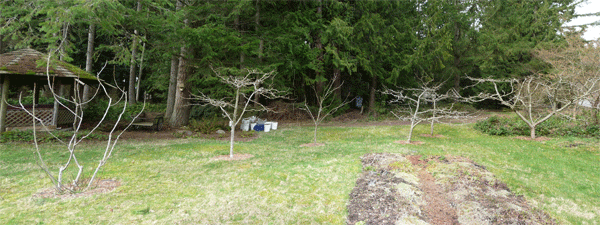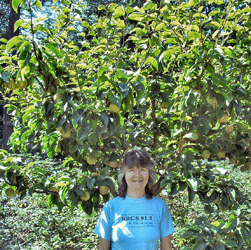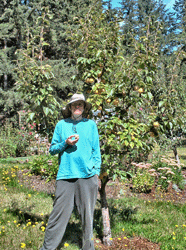Apples
In March 1987, we planted 3 bare root dwarf apples and one bare root semi-dwarf combo apple. The property came with a fairly mature dwarf Yellow Transparent apple.One of the dwarfs didn't survive the very cold (as in 5 degrees) winter of 1988 and had to be replaced in the spring of 1989 when we added yet another dwarf apple to the collection.

The fig tree is on the left and the others are all apples. The combo semi-dwarf is on the right. Photo taken March 21, 2009.
Here's what we're growing now.
- Dwarf Jonagold Apple, 1989
- 2 Dwarf Liberty Apples, one planted in 1987 and one added to the orchard in 1989
- Dwarf Prima Apple, 1987
- Combo Apple consisting of Mutsu/Crispin, King, Macoun and Summered Apples, Semi Dwarf 1987.
- Yellow Transparent, Dwarf
The Liberty is also very disease resistant but doesn't produce as heavy a crop. It's a tart red apple that keeps very well.
The varieties on the combo apple are not a good selection for the Pacific NW. They are all prone to scab and apple maggot. The Mutsu/Crispin produces a huge crop and those that I put footies on this year were pretty nice apples.
Pears
In 1987, we planted 2 Asian Pears and 2 European Pears. One of the Asian Pears didn't survive and we replaced it in 1990.Here's what we're growing now
- Yukuma Asian Pear, Dwarf, 1987
- Shinsui Asian Pear, Dwarf, 1990
- Bosc Pear, Dwarf, 1987
- Bennet Pear, Dwarf, 1987

Meanwhile the Shinsui produces a smaller crop of brown very aromatic crunch pears.

The Bosc is a consistent heavy producer of rough brown-skinned winter pears.
The Bennet which is a Bartlett-type pear has struggled for years but seems to be finally doing better.
Cherries
We planted a dwarf combo cherry in 1987. It's a robust tree that blooms beautifully but doesn't produce many cherries. My theory is that it's too cold and wet most years when it blooms so it just doesn't get good pollination.The Combo tree consists of the following varieties
- Van, a Bing-type and good pollinator
- Lambert, a Bing-type
- Rainier, sweet yellow cherry
- Sam, a Bing-type
- Royal Ann, sweet yellow cherry
Plums
In 1987 I planted a combo plum that had a Santa Rosa Plum and an Italian Prune Plum. The Santa Rosa died in the cold winter of 1988. The Italian Prune produced several crops and then produced a HUGE crop and died.Undaunted I planted a Green Gage Plum in the same spot. It died several years later and I got the hint: that spot has got something wrong with it for plums!
When we moved in there was a flowering plum planted out by the back gate. One wet winter the darned thing fell over. Flowering plums are known to be shallow rooted and the soil out there is very sandy. So I pulled it out and planted an Italian Prune in it's place. It's consistently produced fruit even though it is now being deeply shaded by the Filberts nearby that have gotten HUGE.
Figs
I grew up in southern California around the corner from a fig orchard and I have a great fondness for them. They require lots of sun and heat. In 1988, I planted a Desert King Fig in a whiskey barrel and wintered it over in my greenhouse. Each year we dragged it outside for the summer and I got no figs. Then I tried leaving it in the greenhouse and still didn't get figs. To make matters worse the darned thing rooted into the floor of the greenhouse through the drain holes in the whiskey barrel.In 1993, I gave up and pried it out of the whiskey barrel and planted it in the orchard. Some years it produces a few figs but as the years have gone on, the area where it's planted has gotten shadier (the Doug Firs keep getting bigger and bigger) and the crops have gotten rarer and rarer.

If you want to grow figs in Western Washington, plant them in a VERY sunny and preferably protected spot where it will get nice and hot and you'll probably get plenty of figs.
